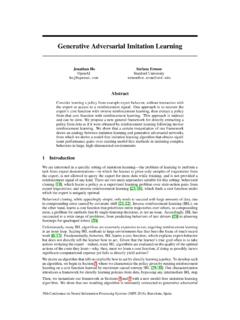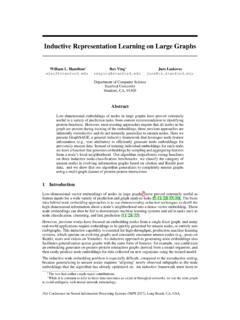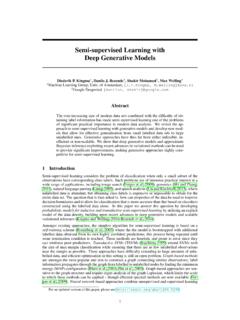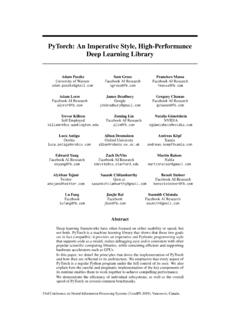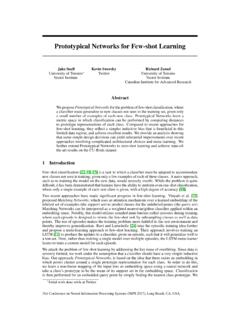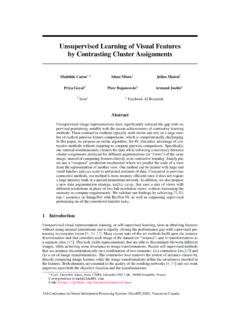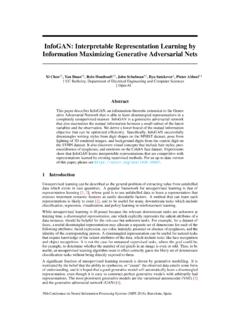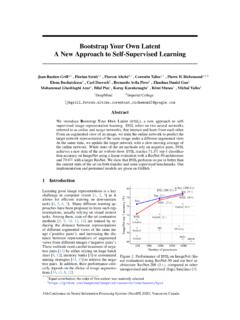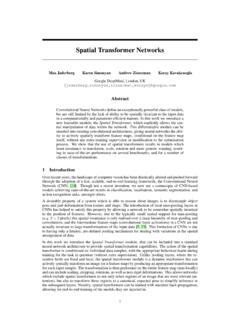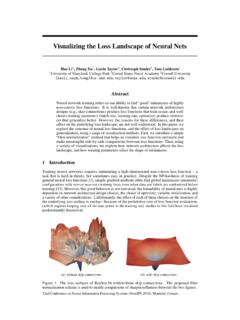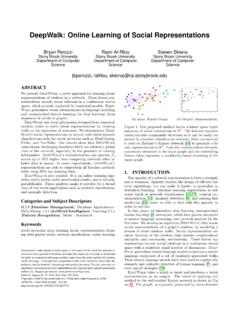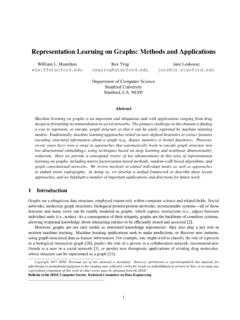Transcription of Translating Embeddings for Modeling Multi-relational Data
1 Translating Embeddings for ModelingMulti- relational DataAntoine Bordes, Nicolas Usunier, Alberto Garcia-Dur anUniversit e de Technologie de Compi`egne CNRSH eudiasyc UMR 7253 Compi`egne, France{bordesan, nusunier, Weston, Oksana YakhnenkoGoogle111 8th avenueNew York, NY, USA{jweston, consider the problem of embedding entities and relationships of Multi-relational data in low-dimensional vector spaces. Our objective is to propose acanonical model which is easy to train, contains a reduced number of parametersand can scale up to very large databases.}}
2 Hence, we proposeTransE, a methodwhich models relationships by interpreting them as translations operating on thelow-dimensional Embeddings of the entities. Despite its simplicity, this assump-tion proves to be powerful since extensive experiments show thatTransEsignif-icantly outperforms state-of-the-art methods in link prediction on two knowledgebases. Besides, it can be successfully trained on a large scale data set with 1 Mentities, 25k relationships and more than 17M training IntroductionMulti- relational data refers to directed graphs whose nodes correspond toentitiesandedgesof theform (head,label,tail) (denoted(h,`,t)), each of which indicates that there exists a relationship ofnamelabelbetween the entitiesheadandtail.
3 Models of Multi-relational data play a pivotal role inmany areas. Examples are social network analysis, where entities are members and edges (relation-ships) are friendship/social relationship links, recommender systems where entities are users andproducts and relationships are buying, rating, reviewing or searching for a product, or knowledgebases (KBs) such as Freebase1, Google Knowledge Graph2or GeneOntology3, where each entityof the KB represents an abstract concept or concrete entity of the world and relationships are pred-icates that represent facts involving two of them.
4 Our work focuses on Modeling multi -relationaldata from KBs (Wordnet [9] and Freebase [1] in this paper), with the goal of providing an efficienttool to complete them by automatically adding new facts, without requiring extra Multi-relational dataIn general, the Modeling process boils down to extracting local orglobal connectivity patterns between entities, and prediction is performed by using these patterns togeneralize the observed relationship between a specific entity and all others. The notion of localityfor a single relationship may be purely structural, such as the friend of my friend is my friend networks, but can also depend on the entities, such as those who liked Star Wars IV alsoliked Star Wars V, but they may or may not like Titanic.
5 In contrast to single- relational data wheread-hoc but simple Modeling assumptions can be made after some descriptive analysis of the data,the difficulty of relational data is that the notion of locality may involve relationships and entitiesof different types at the same time, so that Modeling Multi-relational data requires more genericapproaches that can choose the appropriate patterns considering all heterogeneous relationships atthe same the success of user/item clustering or matrix factorization techniques in collaborativefiltering to represent non-trivial similarities between the connectivity patterns of entities in single- relational data.
6 Most existing methods for Multi-relational data have been designed within the frame-work of relational learning from latent attributes, as pointed out by [6]; that is, by learning andoperating on latent representations (or Embeddings ) of the constituents (entities and relationships).Starting from natural extensions of these approaches to the Multi-relational domain such as non-parametric Bayesian extensions of thestochastic blockmodel[7, 10, 17] and models based on tensorfactorization [5] or collective matrix factorization [13, 11, 12], many of the most recent approacheshave focused on increasing the expressivity and the universality of the model in either Bayesianclustering frameworks [15]
7 Or energy-based frameworks for learning Embeddings of entities in low-dimensional spaces [3, 15, 2, 14]. The greater expressivity of these models comes at the expense ofsubstantial increases in model complexity which results in Modeling assumptions that are hard to in-terpret, and in higher computational costs. Besides, such approaches are potentially subject to eitheroverfitting since proper regularization of such high-capacity models is hard to design, or underfit-ting due to the non-convex optimization problems with many local minima that need to be solved totrain them.
8 As a matter of fact, it was shown in [2] that a simpler model (linear instead of bilinear)achieves almost as good performance as the most expressive models on several Multi-relational datasets with a relatively large number of different relationships. This suggests that even in complexand heterogeneous Multi-relational domains simple yet appropriate Modeling assumptions can leadto better trade-offs between accuracy and as translations in the embedding spaceIn this paper, we introduceTransE, anenergy-based model for learning low-dimensional Embeddings of entities.
9 InTransE, relationshipsare represented astranslations in the embedding space: if(h,`,t)holds, then the embedding of thetail entitytshould be close to the embedding of the head entityhplus some vector that dependson the relationship`. Our approach relies on a reduced set of parameters as it learns only onelow-dimensional vector for each entity and each main motivation behind our translation-based parameterization is that hierarchical relationshipsare extremely common in KBs and translations are the natural transformations for representing , considering the natural representation of trees ( Embeddings of the nodes in dimension2)
10 , the siblings are close to each other and nodes at a given height are organized on thex-axis,the parent-child relationship corresponds to a translation on they-axis. Since a null translationvector corresponds to an equivalence relationship between entities, the model can then representthe sibling relationship as well. Hence, we chose to use our parameter budget per relationship(one low-dimensional vector) to represent what we considered to be the key relationships in , secondary, motivation comes from the recent work of [8], in which the authors learn wordembeddings from free text, and some1-to-1relationships between entities of different types, such capital of between countries and cities, are (coincidentally rather than willingly) represented bythe model as translations in the embedding space.
